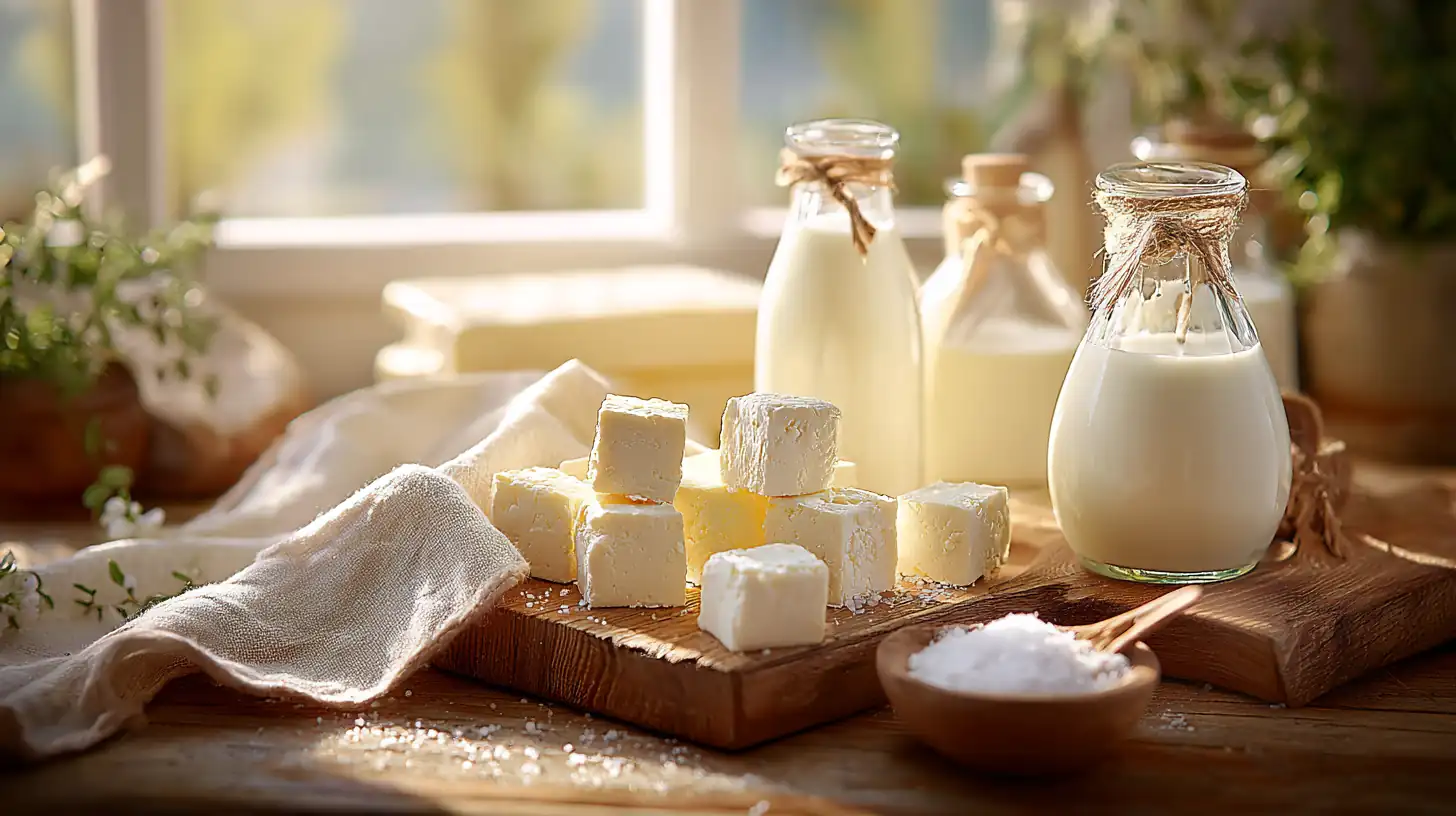
How to Ferment Feta Cheese Like a Pro: The Ultimate DIY Guide
- Total Time: 1 week (including aging)
- Yield: 1 medium wheel (about 1–1.2 lbs) 1x
- Diet: Vegetarian
Description
This step-by-step recipe shows you how to ferment feta cheese at home using traditional methods. Achieve that perfect tangy, crumbly texture with simple ingredients and the right tools.
Ingredients
1 gallon sheep’s, goat’s, or cow’s milk (preferably fresh and high quality)
1/4 tsp mesophilic starter culture
1/4 tsp liquid rennet diluted in 1/4 cup cool, non-chlorinated water
1 tbsp non-iodized salt
Brine solution (6-8% salt: 60-80g salt per 1L water)
Cheesecloth
Cheese mold or colander
Thermometer
Sanitized utensils and containers
Instructions
1. Heat milk to 86°F (30°C) in a stainless steel pot.
2. Sprinkle mesophilic starter culture over the milk and let hydrate for 2 minutes.
3. Stir gently and allow to acidify for 30 minutes.
4. Add diluted rennet and stir gently for 1 minute.
5. Let milk set undisturbed for 45-60 minutes until curds form and a clean break is visible.
6. Cut the curds into 1-inch cubes and stir gently for 10-15 minutes.
7. Allow curds to settle, then transfer them into a cheesecloth-lined mold or colander.
8. Drain whey naturally for several hours; optionally press lightly with 5-10 lbs of weight.
9. Cut drained curds into blocks and submerge in salt brine (6-8%) for 5-7 days.
10. Store in brine and age at 50-54°F (10-12°C) for 1-2 weeks or longer depending on desired flavor.
Notes
Use only non-iodized salt for brining.
Sheep’s or goat’s milk gives the most authentic flavor.
If your feta is too salty after aging, soak it in cold water for 1-2 hours before serving.
Sanitize all tools thoroughly to avoid contamination.
Store finished feta in brine to extend shelf life and maintain flavor.
- Prep Time: 60 minutes
- Cook Time: 0 minutes
- Category: Fermentation, Cheese Making
- Method: Fermentation
- Cuisine: Greek
Nutrition
- Serving Size: 1 oz (28g)
- Calories: 75
- Sugar: 1g
- Sodium: 260mg
- Fat: 6g
- Saturated Fat: 4g
- Unsaturated Fat: 2g
- Trans Fat: 0g
- Carbohydrates: 1g
- Fiber: 0g
- Protein: 4g
- Cholesterol: 25mg
Table of Contents
I still remember the first time I tried to ferment feta cheese. It was a chilly Sunday morning in Asheville, and I’d just brought home a gallon of fresh goat’s milk from the farmers’ market.
The smell took me straight back to my grandmother Mabel’s kitchen – she had this way of turning the simplest ingredients into something unforgettable. With her old wooden spoon in hand and a bit of beginner’s courage, I set out to recreate that same tangy, crumbly magic.
If you’ve ever been curious about making this Greek classic at home, you’re in good company.
This guide walks you through everything: the science behind fermentation, a step-by-step process, and how to fix things when they don’t go as planned.
Let’s get started and make something you’ll be proud to share.
Understanding the Basics to Ferment Feta Cheese
Feta cheese has held a special place in Greek cuisine for centuries. Its distinct flavor and texture are a result of time-honored techniques passed down through generations. In this section, we’ll explore what makes feta cheese unique, the basic science of fermentation, and the key ingredients that lend feta its signature tangy taste.
What Makes Feta Unique?
Feta cheese stands out from other cheeses for several reasons:
- Tangy Flavor and Crumbly Texture
- The brining process and lactic acid bacteria work hand-in-hand to create a bright, slightly salty taste. This tanginess sets feta apart from smoother, milder cheeses.
- The curd structure, formed by traditional rennet or microbial rennet, yields small, crumbly pieces that hold up well in salads, pastries, or even on their own as a table cheese.
- Greek Cheese Fermentation Traditions
- Feta has roots stretching back to ancient Greece, where sheep’s milk and goat’s milk were typically preferred for their richer, more nuanced flavors.
- Modern feta-making sometimes employs cow’s milk, but the true hallmark of Greek-style feta remains sheep’s or goat’s milk aged in wooden barrels or steel containers.
- Culinary Versatility
- Feta’s sharp and savory notes blend seamlessly with salads, roasted vegetables, or even fruit-based dishes (like watermelon-feta salads).
- It’s also a foundational ingredient in Greek favorites like spanakopita (spinach pie) and tyropita (cheese pie).
The Science Behind Fermentation
At its heart, cheese-making is a symbiotic dance between milk and microbes – particularly bacteria that transform lactose into lactic acid. Here’s why this matters when you ferment feta cheese:
- Lactic Acid Bacteria
- These friendly microbes consume lactose (milk sugar), lowering the pH of your cheese.
- A lower pH environment ensures that harmful bacteria struggle to survive, contributing to a safer, tangier product.
- Acidification and Texture
- As acidity increases, proteins in milk (casein) begin to coagulate, forming curds.
- The final texture depends on the extent of acidification, the type of rennet used, and the cutting and draining process.
- Role of Salt
- Salt, often introduced via a salt brine, controls microbial growth and draws out moisture.
- Salinity is a critical factor in aging feta cheese: too little salt leads to spoilage; too much can render the cheese inedibly salty.
Key Ingredients to Successfully Ferment Feta Cheese for Optimal Flavor
To ferment feta cheese successfully, you’ll need a few crucial ingredients:
- Milk Selection
- Sheep’s milk or goat’s milk is often preferred in authentic Greek feta for its higher fat content, richer flavor, and traditional taste.
- Cow’s milk can also be used, though the result tends to be milder and less tangy.
- If you enjoy working with fresh dairy, you might also love trying these cottage cheese banana pancakes – a fun way to use leftover milk.
- Rennet
- Rennet contains enzymes that curdle the milk, helping separate solids (curds) from liquid (whey).
- You can find both animal-based and microbial rennet options, depending on your dietary preferences.
- Starter Cultures
- Mesophilic and thermophilic cultures each work within certain temperature ranges, influencing flavor development.
- Some home cheesemakers rely on natural bacteria from raw milk, though this method can be less predictable.
- Salt Brine
- Ensures the cheese remains properly salted and protected from undesired microbes.
- Influences the cheese’s crumbly texture and tangy taste.
Gathering the Essential Tools and Ingredients to Ferment Feta Cheese
Before you jump into the actual process, assembling the correct tools and ingredients ensures a smoother, more enjoyable cheese-making experience. Having everything within reach can make the difference between frustration and success.
Essential Equipment Checklist to Ferment Feta Cheese Like a Pro
Investing in the right equipment makes it significantly easier to ferment feta cheese at home:
- Cheesecloth
- A fine-weave cheesecloth helps to drain the curds, preserving their structure while removing excess whey.
- Choose high-quality, food-grade cloth to avoid unwanted fibers in your cheese.
- Thermometer
- Accurate temperature control is critical for starter cultures to thrive and produce the right level of acidity.
- A digital or instant-read thermometer ensures precise readings throughout the process.
- Cheese Molds and Press
- While feta doesn’t always require heavy pressing, specialized molds aid in shaping and draining the curds effectively.
- If you plan to make larger batches, a small cheese press can help achieve consistent moisture content.
- Sterilized Containers and Utensils
- Cleanliness is vital when you ferment feta cheese, as contamination can spoil your batch.
- Use boiling water or food-safe sanitizers to sterilize all surfaces and containers beforehand.
Choosing the Right Milk
Since the milk you select plays a defining role in flavor and texture, consider these factors:
- Sheep’s Milk vs. Goat’s Milk
- Sheep’s milk typically has a higher butterfat content, resulting in a creamier, more robust flavor.
- Goat’s milk can offer a slightly tangier, earthy note and is generally more digestible for those sensitive to cow’s milk.
- Pasteurized vs. Raw Milk
- Pasteurized milk: More predictable fermentation due to reduced microbial competition, but it might lose some nuanced flavors.
- Raw milk: Can lead to distinctive, regional flavors, though it comes with higher safety precautions and variance in bacterial content.
- Local Sourcing
- Fresh, high-quality milk often yields the best flavor and consistency.
- Consider visiting local farms or farmers’ markets to find premium milk.
Starter Cultures and Rennet
While some cheesemakers rely on the natural flora in raw milk, using a defined starter culture and rennet ensures predictable results:
- Mesophilic Cultures
- Operate best between 86°F-95°F (30°C-35°C).
- Often used for softer, tangy cheeses like feta, contributing bright, clean flavors.
- Thermophilic Cultures
- Thrive in slightly higher temperatures (100°F-115°F or 38°C-46°C).
- May impart a more complex flavor profile, though less commonly used for feta. Love soft cheeses? Then you’ll definitely want to try filling fresh pasta with something like this burrata ravioli – an indulgent next step for cheese lovers.
- Rennet Potency
- Rennet strength varies, so follow the manufacturer’s instructions carefully.
- Ensure it hasn’t expired; old rennet can lead to inconsistent or weak curd formation.
Step-by-Step Guide to Ferment Feta Cheese
Once you’ve gathered your ingredients and cleaned your tools, you’re ready to make feta cheese from scratch. Let’s walk through each phase – from heating the milk to aging the final curds – so you can confidently create a batch that’s rich, tangy, and entirely homemade.
Phase One: Heat, Culture & Form the Curds
Warm the Milk Gradually
Pour your milk into a large, clean stainless-steel pot and gently warm it to 86°F (30°C). Stir occasionally and use a reliable thermometer to monitor the temperature – accuracy here supports bacterial growth later on.
Add the Starter Culture
Sprinkle a mesophilic starter culture directly over the milk’s surface. Allow the culture to sit for a minute before gently mixing it into the milk with slow, vertical strokes to avoid splashing. Cover the pot and allow the culture to do its work for about 30 minutes, maintaining a steady temperature.
Incorporate the Rennet
Dissolve liquid or tablet rennet in a small amount of cold, chlorine-free water. Slowly add the rennet while stirring the milk in smooth, circular motions for 30 seconds to mix it thoroughly. Once fully mixed, cover the pot and set it aside without moving it. Cover the pot once you’ve stirred the milk, then step away – this pause gives the cultures the stillness they need to begin curd formation. This quiet time lets the milk start changing on its own, beginning the curdling process.
Let the Curd Firm Up
Let the milk sit quietly for 45 to 60 minutes until it firms up into one smooth, softly set mass. Test the curd by slipping a knife in on a slant – if the cut holds together without falling apart, it’s time to proceed. If it lifts easily and the surface stays firm and intact, it’s ready for cutting. If the curd separates cleanly and the edge looks sharp, it’s ready for slicing.
Cut & Stir the Curds
Use a long, sterile knife to cut the curd into uniform 1-inch squares. Let them rest for 5 minutes. Stir the curds slowly for 10 to 15 minutes to help drain excess whey and encourage a tighter, more compact texture. Once stirred, allow the curds to settle again.
Phase Two: Drain, Salt & Age the Cheese
Transfer the Curds to Drain
Line a cheese mold or colander with cheesecloth. Spoon the curds carefully into a cheese mold or lined colander, allowing liquid to drain as you go. Let the whey drain away naturally over several hours.
Optional Light Pressing
If you prefer a firmer texture, press the cheese gently using a cheese press or weighted plate – no more than 5-10 pounds of pressure for about 2-3 hours.
Prepare the Brine Solution
In a clean container, mix 60-80 grams of non-iodized salt per liter of water (or 2-3 ounces per quart). Stir until fully dissolved to create your salt brine.
Brine the Cheese
Cut your feta into smaller blocks and submerge them fully in the brine. Initially, they may float – this is normal as air and residual whey escape. Let the cheese soak for at least 24 hours to begin developing flavor.
Control the Aging Temperature
Place the brining container in a cool area – ideally 50°F to 54°F (10°C-12°C). A cheese fridge or basement works well, but a standard refrigerator will suffice, just with slower aging results.
Phase Three: Flavor, Texture & Storage Checks
Monitor the Taste
After a few days in brine, sample a small piece. The flavor should be tangy and slightly salty. If not salty enough, brine it longer or adjust the solution. If too salty, soak the block briefly in cold water before serving.
Inspect Texture and Odor
Healthy feta should be firm yet crumbly. If it smells unpleasant or shows discoloration, discard it – it may be contaminated. Mushy texture often points to over-hydration or weak curd formation.
Store Properly for Longevity
Keep the feta fully submerged in brine within a sealed container. Replace the brine every few weeks, or sooner if it turns murky or develops an off smell. For longer-term storage, refrigerate the cheese for up to a month, or freeze it – though freezing may slightly alter the texture.
Troubleshooting Common Issues When You Ferment Feta Cheese
Even seasoned cheesemakers run into occasional hiccups. Below are some of the most frequent problems and how to address them when you ferment feta cheese.
Texture Problems
- Soft or Mushy Cheese
- Possible Causes: Insufficient pressing, low acidity, or high moisture retention.
- Solutions: Try extending the draining time, slightly increasing the fermentation temperature (while staying within safe limits), or boosting the salt level to encourage better texture and flavor development.
- Overly Crumbly Texture
- Possible Causes: Cutting curds too small or aging in an overly strong salt brine.
- Solutions: Adjust your cutting technique or decrease brine strength. You can also reduce pressing time if you’re using a cheese press.
Off-Flavors or Odors
- Contamination
- Possible Causes: Poor sanitization of equipment, exposure to undesirable microbes.
- Solutions: Sterilize everything meticulously. If unpleasant or suspicious flavors remain, it’s best to discard the cheese rather than risk it being unsafe to consume.
- Improper pH Levels
- Possible Causes: The milk may not acidify correctly due to weak cultures or unstable temperature during fermentation.
- Solutions: Double-check your thermometers and ensure your starter cultures are fresh and viable.
Salinity and Moisture Control
- Excessive Saltiness
- Possible Causes: Overly concentrated brine, extended aging in brine.
- Solutions: Soak the cheese in unsalted water or milk before serving. Aim for around 6-8% salt in the brine next time.
- Too Dry
- Possible Causes: Prolonged pressing or using too high brine concentration.
- Solutions: Shorten pressing times, reduce brine strength, and store in an environment with slightly higher humidity.
Serving, Pairing, and Enjoying the Feta Cheese You Ferment at Home

Your carefully aged feta is finally ready to take center stage in your kitchen creations. Its rich flavor and crumbly texture make it an adaptable ingredient that complements countless dishes – both familiar and adventurous.
Timeless Mediterranean Uses
Greek-Inspired Classics
The bold, tangy flavor of feta stars beautifully in a traditional Greek village salad – just toss it with juicy tomatoes, crisp cucumbers, kalamata olives, sliced red onions, and a drizzle of olive oil. A dash of oregano brings the flavors home.
Feta brings a bold, tangy edge that elevates any savory pastry to something special. Try folding it into a homemade spanakopita, or mix it into a hearty herb quiche. For something simpler, pair your feta with creamed spinach for a wholesome, rustic plate.
Appetizer Boards & Tapas
Set out your feta as part of a Mediterranean platter: crusty bread, pickled vegetables, marinated olives, and cured meats. You can serve it whole or cubed, lightly dressed in olive oil. Pair with tangy sides like a vinegar-kissed seafood salad to round out the spread. You’ll find it also pairs wonderfully with other antipasti like roasted red peppers or eggplant caponata.
Contemporary Dishes and Unique Pairings
Modern Meal Twists
Want to switch up your weeknight meals? Sprinkle feta over warm roasted vegetables or swirl it into herby tomato sauces. It works perfectly as a topping for this pesto-dressed pasta or folded into warm grain bowls.
Love homemade pizza? After baking, scatter feta across your flatbread or sourdough base for a burst of creamy tang. It works especially well with peppery arugula or fresh basil. Balance rich entrées like braised short rib ravioli with a sprinkle of feta for a creamy, tangy finish that cuts through the depth. For a low-carb twist, try topping your cottage cheese pizza crust with crumbled feta – its sharp bite adds depth without overwhelming the dish.
Dips, Sauces, and Beyond
Whip feta into a smooth, savory blend with charred red peppers, finely grated garlic, and a drizzle of rich olive oil. Want something lighter? Combine it with thick Greek yogurt and a handful of finely chopped herbs like dill or mint. These flavorful mixes go perfectly with grilled veggies or warm slices of pita.
Unusual But Delightful Sweet Pairings
Feta can surprise you on the sweet side of the plate. Try pairing it with ripe fruit – like watermelon, peaches, or figs – and finish with a drizzle of honey or scatter of fresh herbs. It adds a salty edge that elevates the entire flavor experience.
Proper Storage and Aging Tips
Keep It Fresh in Brine
To extend your feta’s life, store it fully submerged in a mild salt brine. Monitor the saltiness as it ages; adjust the concentration if the flavor becomes overpowering. Use a clean container and refresh the brine monthly if needed.
Fridge and Freezer Guidelines
Keep feta refrigerated in a tightly sealed container. If the brine looks cloudy or overly strong, it’s time to change it. While freezing is an option, expect a more crumbly texture once thawed. It’s still great for cooking!
Letting Feta Mature
If you’re aiming for a punchier, more robust feta, aging longer is the secret. Let your blocks mature in cold storage or a cheese cave for several weeks – or even months. Just remember: the longer it rests, the stronger and saltier it becomes.
Frequently Asked Questions About Feta Cheese
What cheese does feta taste like?
Feta cheese has a sharp, salty flavor with a tangy edge that sets it apart. If you’re looking for a comparison, it’s somewhat similar to goat cheese or queso fresco but firmer and more crumbly. The brined aging process gives feta its bold bite, making it stand out in salads, pastries, or Mediterranean spreads.
Is feta cheese made from cow or goat milk?
In most Greek-style preparations, feta is crafted using sheep’s milk or a combination of sheep and goat milk for a full-bodied, authentic flavor. However, some modern versions—especially those made outside of Europe—use cow’s milk for a milder taste. To maintain its bold taste and crumbly texture, true feta is rarely made with cow’s milk.
Is feta cheese really healthy?
Feta fits well into a balanced diet, offering protein, nutrients, and lower fat compared to many aged cheeses. It’s lower in fat and calories than many aged cheeses and contains probiotics that support gut health. Plus, it offers calcium, protein, and B vitamins. Just keep an eye on sodium levels, since feta is stored in brine and naturally salty.
Is feta the healthiest cheese?
Feta cheese ranks among the healthier cheese options due to its high nutrient content and lower fat. Compared to cheddar or creamier varieties, feta provides good protein with fewer calories. Its probiotic content also supports digestion. That said, moderation is key because of its high sodium from the brine.
Conclusion and Final Thoughts
Making feta cheese at home is more than just a culinary project – it’s a journey into the heart of Greek cheese-making traditions. By learning to ferment feta cheese yourself, you unlock a world of tangy, crumbly flavors that can’t be replicated by mass-produced blocks found in grocery stores. Whether you’re a food enthusiast looking to experiment or just want to level up everyday dishes like these baked beans, DIY feta offers a fulfilling path to explore your creativity in the kitchen.
Have you tried to ferment feta cheese using the steps outlined in this guide? Tell us how your feta-making adventure went – whether it was smooth or a little bumpy. Your story could inspire and guide other home cheesemakers on their journey. Don’t forget to subscribe to our newsletter for more in-depth cheese-making tutorials, recipes, and kitchen inspiration. Happy fermenting!
- Homemade feta cheese makes a fantastic topping for these Baked Beans, adding a creamy, tangy contrast to the rich, savory flavors.
- For a delicious Mediterranean twist, crumble some feta cheese over this Lumache Pasta and enjoy a perfect combination of flavors.
Follow me on Facebook for daily updates and community fun.

